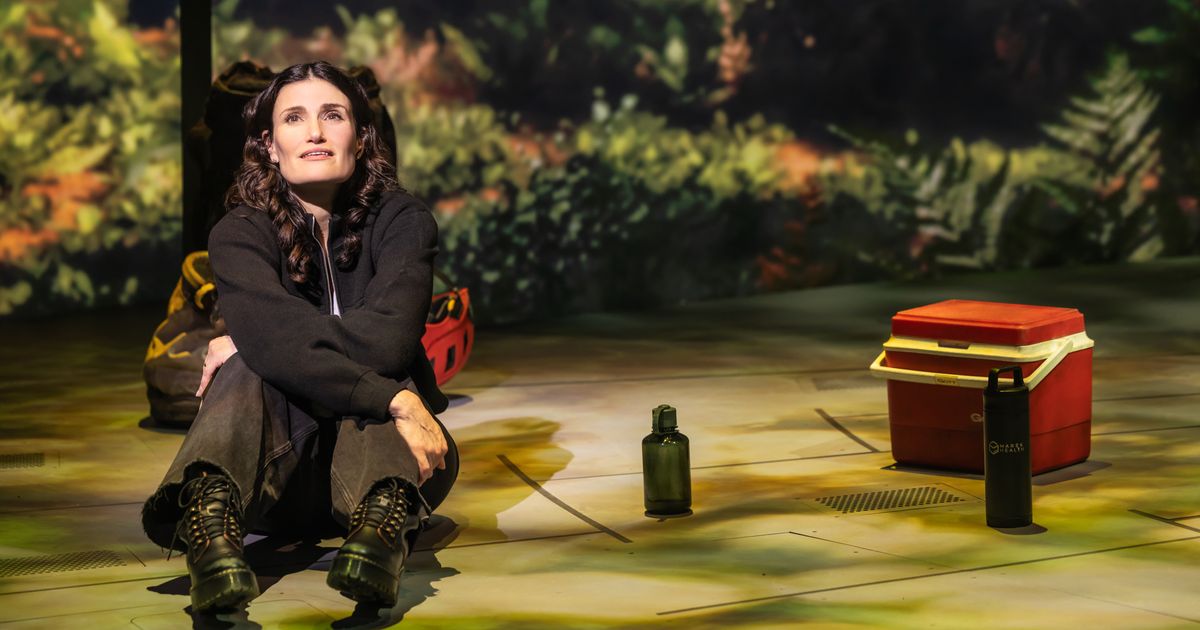All Bark, No Bite: Redwood
Idina Menzel grieves in a tree and leaves.


Reviewing plays about trauma and grief can sometimes feel a bit like attempting to ship your grandmother’s crystal punch bowl through the mail. The process takes gloves, layers of cushioning, labels announcing “FRAGILE: HANDLE WITH CARE” — the material, regardless of quality, seems to present an ethical demand for delicacy. But while we’re busy treading on the eggshells of sensitive ingredients, what of the thing that’s actually been created with them? Here, sans bubble wrap, is the plot of Redwood, the new musical starring Idina Menzel and co-conceived by the Tony-winning diva with director Tina Landau:
A successful New York gallery owner is grieving the loss of her 23-year-old son. As the first anniversary of his death approaches, she goes into a tailspin, stops answering calls and texts from her partner of 20 years, and drives to Northern California. There, in a section of old-growth forest that’s not open to tourists, she emotionally strong-arms two ecological researchers into strapping her into a harness and taking her up into the canopy with them. High up on a platform in the overstory, where the researchers — against the better judgment of the less romantic of the pair — eventually allow her to live for several days, she communes with nature (the tree, she asserts, tells her its name is Stella), briefly considers suicide, and faces fires both spiritual and conveniently literal. The trees work their ancient cathartic magic. She climbs down a changed woman, ready to go home.
Build a tower on a foundation of schmaltz, and the thing starts to sink as soon as you breathe on it wrong. Perhaps Menzel, along with Landau and Kate Diaz — who collaborated on the show’s lyrics while Diaz, a newcomer to musical theater, wrote the score — is banking on music’s ability to sweep us along, softening the edges of our need for certain kinds of logic as a river smooths a stone. But if the music exists that could satisfactorily burnish over Redwood’s simultaneous thinness and wonkiness as a narrative, its creators haven’t found it yet. I know I’m supposed to feel for Jesse (Menzel) as her suffering drives her to perform a kind of Elizabeth Gilbert–meets–Cheryl Strayed–meets–Christopher McCandless recovery road trip, but I just have too many questions. Is this woman really going to hold the time-sensitive research of two botanists hostage to her own personal trauma? Is the canopy, as botanist Becca (Khaila Wilcoxon) claims, really “the safest place to be” during a forest fire, even as the smoke rises? Are Becca and her senior colleague, botanist Finn (Michael Park), really studying carbon sequestration, or do they exist to offer distraught city folk a smorgasbord of woodsy metaphors for better living? E.g.: Redwoods have surprisingly shallow roots for their height, which means that the trees support themselves by sending their roots out horizontally and interlocking them with those of their neighbors across miles and miles of forest — a legitimately beautiful fact that’s rapidly reduced to cringe by lyrics like “Hear the secrets in their silence, / The ancient wisdom of the giants. / The trees’ most important lesson / Is that like the roots, / We need connection.”
More questions. Does Jesse have to be from New York? Is the Redwood team convinced that a Broadway audience won’t follow her into the woods unless she makes constant references to doing “yoga at my old synagogue,” how “if I even think about grass, I get Lyme disease,” and the traffic on the L.I.E.? Unless she’s married to a hip photojournalist (De’Adre Aziza) and starts her journey as a city-mouse cliché, rolling her eyes at the thought of becoming one of those “granola people, tree-hugger people”? Also, is Redwood actually an IMAX experience? The set, by Jason Ardizzone-West, consists of a raked white floor of interlocking panels (like the cladding of the Death Star, flattened out with a rolling pin) and a curved surround of more panels, towering and blank, soldiers ready to receive the inevitable full blast of constant LED video. And although aspects of Hana S. Kim’s video design are sometimes exciting — there’s a genuinely lovely moment in which the shadow of a baby redwood grows up the massive trunk of the set’s central realistically modeled showpiece tree, which is revealed when the middle standing panel rotates — I went through much of the show’s 110 minutes with the queasy feeling of being at Epcot or, worse, inside some future Immersive Forest Experience, an AI-generated simulator from an age of total climate collapse, designed to give humans a nostalgic reminder of what trees were like.
Meanwhile, against Stella’s mammoth trunk and amid this barrage of pixels, Menzel is busy doing what she’s best at, defying gravity. Melecio Estrella and his aerial-dance company, Bandaloop, are credited with Redwood’s aerial choreography and “vertical movement,” and Jesse, Becca, and Finn all spend a good deal of the story buckling into harnesses, pulling on carabiners, and hoisting themselves toward the flies. So much dialogue is dutifully devoted to safety checks (“Ascender is grabbing. Carabiner is locked. Rope is through the rig, to the locked carabiner, to the hard point. Buckles. Ready to climb”) that for a long time I was sure someone would eventually fall — but no, it’s not a Chekhov’s gun, just some folks earnestly looking out for one another, most likely as both characters and actors. Onstage flight is always fun, and there are some sparks of joy in watching Wilcoxon and Park confidently push off of the big trunk, and to seeing Menzel’s Jesse evolve from tentative newbie into barefoot, air-dancing nature mama. But Redwood is too soggy a show for any spark to catch, especially when Jesse is passionately belting lyrics like “In my heart, I’m suddenly at peace,” “It’s nature’s remedy,” and “In the leaves / I’m a kid again. / In the green / I can now begin / Laughing, / Laughing in the leaves.” Perhaps it’s pedantic, but there’s something generic and odd about being 300 feet up an evergreen tree and singing about leaves. (Yes, an evergreen needle is technically a leaf, but neither Finn nor Becca — despite their penchant for exposition — has explained as much to Jesse. Maybe Stella filled her in between scenes.)
The idea for Redwood apparently first came to Menzel when she heard the story of Julia Butterfly Hill, an environmental activist who lived at the top of a redwood tree for two years in the late 1990s to protest its felling by the Pacific Lumber Company. Extraordinarily, she won, and Menzel isn’t the only one to find the story compelling — Hill has found her way into songs by Neil Young and the Red Hot Chili Peppers and into Richard Powers’s densely gorgeous 2018 novel, The Overstory. There’s guts in Menzel and Landau’s desire to pursue an original inspiration and in bringing on a young composer to collaborate in the creation of something new in a field that runs on rehashes and revivals. Yet Redwood’s DNA contains none of the radical resolve, none of the sense of injustice, that took Hill up into the canopy. There’s hardly a mention of climate-change in the show. And no matter how many enlightened metaphors it deploys over “the ancient wisdom of the giants,” its fundamental structure tells us that the living world is only really significant insofar as it can serve as our therapist. Sure, better a Jesse than the Pacific Lumber Company, but there’s still a sentimental solipsism in Redwood, an uneasy aspect of emotional tourism smothered in a broadside of throw-pillow truisms on connection, growth, and healing. Jesse’s son (Zachary Noah Piser), who appears to her in memories and visions throughout the play, may eventually offer her absolution, but for true catharsis, we need to have felt something, have risked something, and for all its soaring vocals and vertical movement, Redwood leaves us stubbornly grounded.
Redwood is at the Nederlander Theatre.
Related








